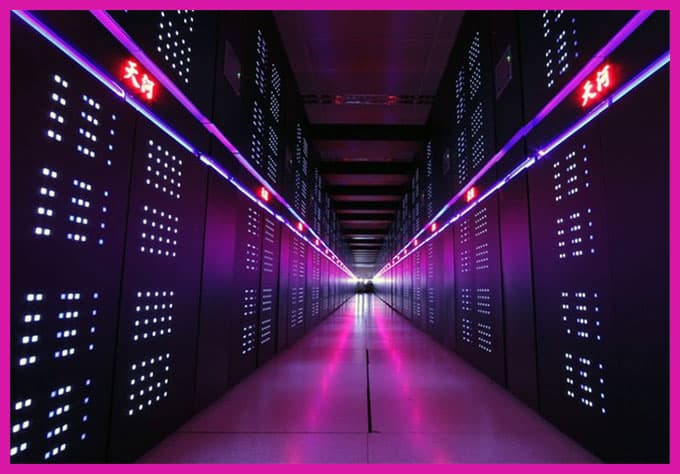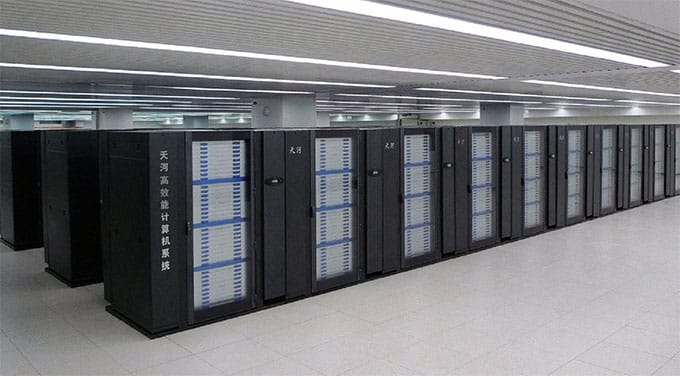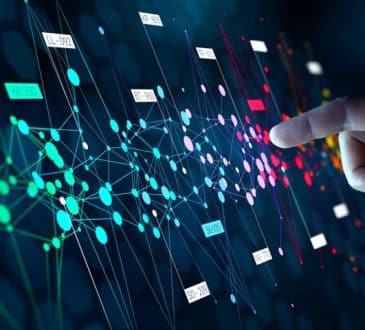10 Mightiest Computing Machines: The Fastest Supercomputers In The World

China’s quest for world domination has added a new chapter — Chinese government-run National University of Defence Technology has built the world’s fastest supercomputer (Tianhe-2), almost doubling the speed of the America’s Titan supercomputer… shows how China is leveraging rapid economic growth to join the United States, Europe and Japan in the global technology elite.
The project was sponsored by the Chinese government’s 863 High Technology Programme – an effort to make the country’s hi-tech industries more competitive and less dependent on overseas rivals.
The US has the world’s second and third fastest supercomputers, Titan and Sequoia, while Japan’s K computer drops to fourth spot.
Supercomputers are used for complex work such as modelling weather systems, simulating nuclear explosions and designing jetliners.
Fastest supercomputers:
10) Tianhe-1A, National Supercomputing Center in China – Ranked #1 in November 2010, Tianhe-1A uses Intel Xeon CPUs and Nvidia GPUs across its 183,368 processing cores for a rating of 2.6 petaflops.

9) SuperMUC, Leibniz Supercomputing Centre in Germany – Using IBM iDataPlex servers, 300TB of RAM, and an InfiniBand interconnect, SuperMUC’s 147,456 cores achieved a speed of 2.9 petaflops. Energy costs are cut by directly cooling chips and memory with water at unusually high temperatures of 104 degrees fahrenheit.
8) Vulcan, Lawrence Livermore National Laboratory – This 4.3 petaflop system is based on IBM’s Blue Gene/Q supercomputing technology and has 393,216 cores. This supercomputer isn’t devoted solely to government use; Vulcan was recently opened to industry and research universities for collaborative projects.
7) Juqueen, Jülich Supercomputing Centre in Germany – Another Blue Gene/Q system, Juqueen’s 458,752 cores hit speeds of 5 petaflops. Using 2,301 kilowatts of power, Juqueen was rated the fifth most energy efficient Top 500 supercomputer last November.
6) Stampede, Texas Advanced Computing Center at University of Texas – With Dell PowerEdge servers powered by Xeon processors and an InfiniBand interconnect, Stampede scored 5.2 petaflops. It is one of the largest systems in the world devoted to open science research—any researcher at a US institution can submit a request to use some of its computing power.
5) Mira, Department of Energy’s Argonne National Laboratory – This Blue Gene/Q system uses 786,432 cores to hit 8.6 petaflops. When it hits full production in 2014 Mira will offer more than 5 billion computing hours per year to scientists (counting time on each core separately).

4) K computer, RIKEN Advanced Institute for Computational Science in Japan – Ranked #1 in the world in 2011, the K computer was made by Fujitsu. Delivering 10.5 petaflops with 705,024 Sparc cores, the K computer uses a six-dimensional torus interconnect called Tofu.
3) Sequoia, Lawrence Livermore National Laboratory – The world’s #1 supercomputer in June 2012, Sequoia is used by the National Nuclear Security Administration to conduct simulations aimed at extending the lifespan of nuclear weapons. The Blue Gene/Q system has nearly 1.6 million cores and hits speeds of 17.2 petaflops.
2) Titan, Oak Ridge National Laboratory – Titan was #1 last November with a speed of 17.6 petaflops. The system uses AMD-based Cray CPUs and Nvidia GPUs in its 560,640 cores. Rated the third most energy efficient supercomputer last November, Titan uses 8,209 kilowatts of power.
1) Tianhe-2 (meaning Milky Way-2) – It was developed at China’s National University of Defense Technology and will be deployed in the country’s National Supercomputing Center before the end of this year — with a performance of 33.86 petaflop/s. Tianhe-2 uses Ivy Bridge-based Intel Xeons and Intel Xeon Phi for a total of 3.12 million cores. The computer uses 17,808 kilowatts of power and can theoretically hit speeds of up to 54.9 petaflops.
Add CEOWORLD magazine to your Google News feed.
Follow CEOWORLD magazine headlines on: Google News, LinkedIn, Twitter, and Facebook.
This report/news/ranking/statistics has been prepared only for general guidance on matters of interest and does not constitute professional advice. You should not act upon the information contained in this publication without obtaining specific professional advice. No representation or warranty (express or implied) is given as to the accuracy or completeness of the information contained in this publication, and, to the extent permitted by law, CEOWORLD magazine does not accept or assume any liability, responsibility or duty of care for any consequences of you or anyone else acting, or refraining to act, in reliance on the information contained in this publication or for any decision based on it.
Copyright 2024 The CEOWORLD magazine. All rights reserved. This material (and any extract from it) must not be copied, redistributed or placed on any website, without CEOWORLD magazine' prior written consent. For media queries, please contact: info@ceoworld.biz
SUBSCRIBE NEWSLETTER








